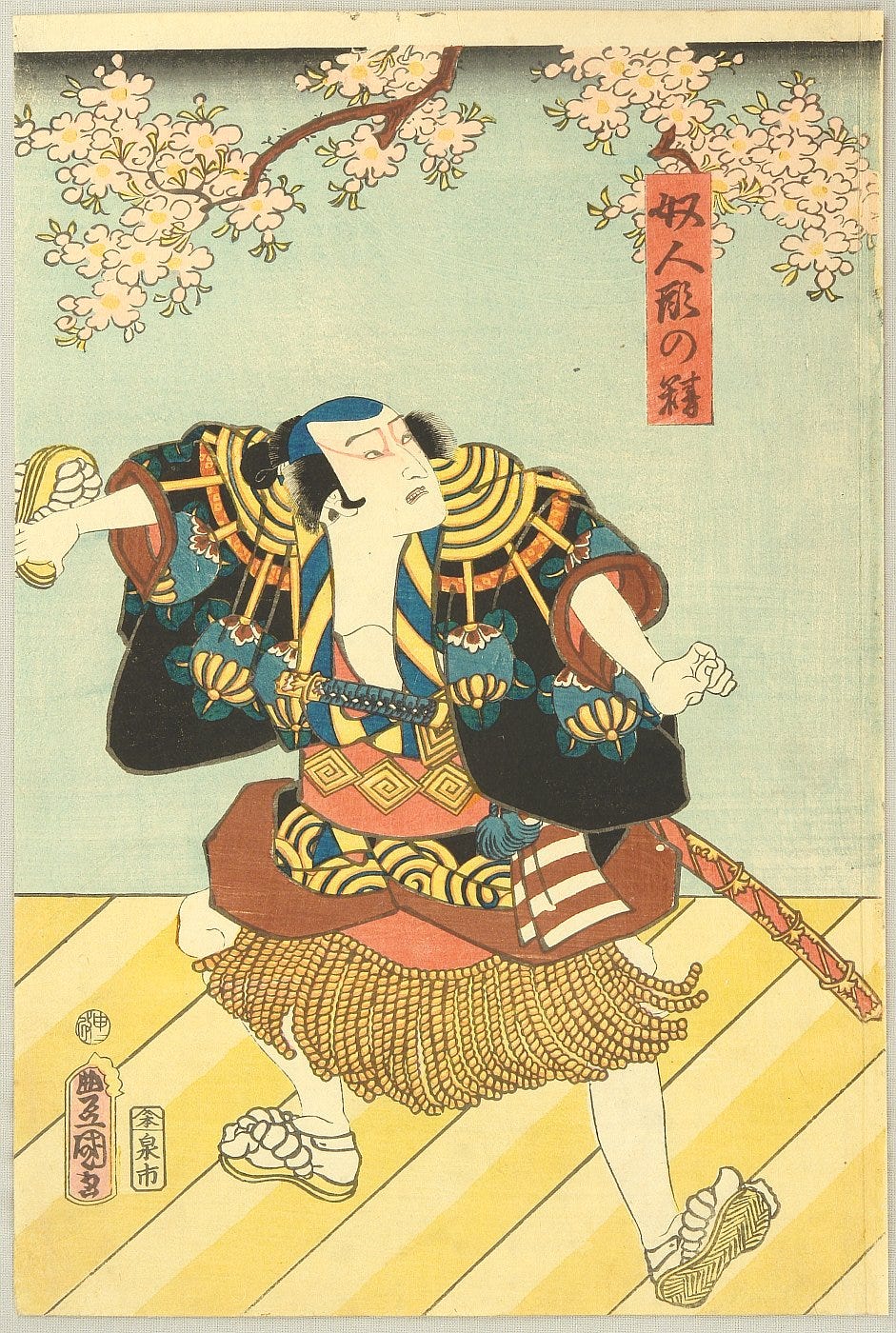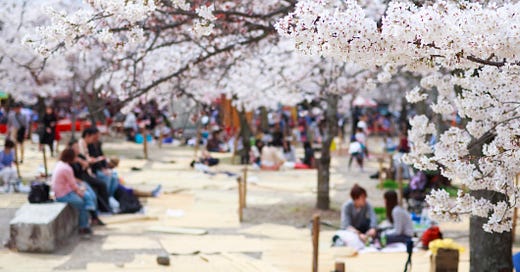It’s been a long winter turned dreary spring, but outside my window, there is a tree bursting into pink. Cherry blossom season is one of my favorite times of year, especially in Japan. Sakura trees bloom from late March, in warmer Kyushu, to early May in colder Hokkaido. In the week of peak bloom, everyone flocks to picnic under the trees in a joyful ritual called hanami, or flower viewing. Even weather reports on TV include a “hanami watch,” indicating the precise days of maximum blossom. When I lived there, I loved partaking in this tradition, especially for the people-watching. The best part was seeing the stoic faces of the old men light up into playful smiles. Drunk off of flowers and umeshu, sweet plum wine, they would laugh gazing up at the soft, swaying petals until eventually passing out for a nap. When you’re surrounded by beauty and the collective effervescence of hanami, it’s hard not to feel similarly swept away. With or without umeshu, it’s an intoxicating experience. A breeze passes, and you find yourself in a whirlwind of snowing petals, the ground carpeted by its confetti. At night, walking underneath sakura trees feels hauntingly beautiful, the moonlight reflects off of the clouds of tiny, trembling blossoms, creating a rare fluorescent florescence.
Hanami can be a rowdy celebration, but it also inspires quiet reflection—you’re more prone to poetry here than in any other time of year. (The umeshu helps too.) The falling petals remind us of how delicate and ephemeral life is. Staying present in gratitude and in nature’s stillness honors our fleeting time. The tradition of hanami goes all the way back to the Nara Period in the 700s, finding roots in Shinto beliefs, Buddhist philosophy, and Bushido code. For samurai, sakura symbolized an ideal, honorable death—a short but glorious life span, falling to earth in prime beauty. There is a deep kinship between fierce warrior and gentle flower, violence released into the grace of an open bloom. A lifetime of battle craves a soft end. In Japanese, the word for ‘baby’ (akachan 赤ちゃん), breaks down as ‘aka’ 赤, meaning red, and ちゃん ‘chan,’ an endearing honorific. The samurai’s ultimate life is a rosy one, born as red to fade in pink.

For me, sakura pink feels like trying to hold onto joy. It aligns me in nature, in culture, in my memories, and in the present all at once. I barely have time to process it before it lets go.
Think Pink
Colors equip us with a visual language to express feelings and connect to deeper metaphors. They create psychological relationships to our memories. We project cultural, historical, and societal associations onto them. I’m curious about the power of colors and their ability to affect us. Is there a way we can map out color trends alongside shifts in societal attitudes? In honor of spring and the return of color, for Volume 02, we’re focusing on PINK and what it can reveal.
While every color weaves a deep history across cultures, certain hues gain enough influence to capture the zeitgeist. At present, pink seems to have us in a headlock. Pantone crowned two Colors of the Year in 2016: Serenity, a long-forgotten pale periwinkle blue, and Rose Quartz, an enduring light pink with beige undertones. We now refer to it as Millennial pink. Seven years reigning, it has become quite the aesthetic tyrant.

What is it about pink that provokes such a range of emotions and associations? As much as it is soft, it’s shocking. It’s political and provocative. As a projection of femininity, it’s charged by sex. It’s queer. It’s punk. It’s as dainty as your grandma’s decorative soaps and as soothing as Pepto Bismol. It’s as seductive as Marylin Monroe, as twee as Wes Anderson cinematography, and as romantic as a Fragonard swing.

I’m thinking about my own changing attitudes towards pink. In Western culture, girls are branded by it from birth. I love it now, but I hated pink as a kid. I somehow internalized that by wearing pink people would not take me seriously. Despite my attempts to override it, I still feel this way. It’s scary how these ideas creep into our brains so early.
For me, rejecting pink meant defying expectations of femininity and softness, often coded as weakness. Expected to sweeten us, pink provokes rebellion.
And speaking of rebellion, like many of you this week, I've been consumed and infuriated by the news of Justice Alito’s leaked draft opinion to overturn Roe vs. Wade. I’m reminded that pink is often the default color at many protests for women’s rights. The pink pussy hat for example, became the national symbol for revolutionary headgear at every Women’s March in 2017.
We look to history for inspiration, for some marker of how far we’ve come and how we can’t go back. Images of women’s protests past re-surface, from suffragettes dressed in white to unite in protest for their right to vote, to the all-white outfits worn by the Democratic women of Congress at the 2019 and 2020 State of the Union Addresses. It’s a kind of pattern, this political color theory. Get mad to the point of seeing red. Then wear white. It blurs together. The revolution is pink until further notice.
Certain color associations, while well-meaning in intent, can prove problematic. Pink pussy hats, with their cheeky nod to genitalia, centers white women and can read as non-inclusive for BIPOC, transgender, and nonbinary communities. The same goes for white and its problematic associations with white supremacy and misguided ideas around purity. What could a more inclusive solidarity color look like? In Latin and South American countries—Mexico, Colombia, Argentina, Paraguay, and Brazil to name a few, demonstrators protesting for safe and legal abortion wear green bandanas, a more recent symbol for reproductive rights.
The Haunted Pussy Bounce House
Before the SCOTUS news hit, I started writing about a funny memory involving pink that happened in a college art class. But, my present rage adds a fresh layer of perspective to that past. For our final projects, our professor assigned us to create a large inflatable sculpture made from industrial plastic sheeting. We presented our initial ideas first as rough sketches. One of my classmates shared her drawing for an installation of an inflatable, walk-in vagina. She flipped her sketchbook page to show a box with concentric squiggles, indicating labia in perspective, and spoke to her vision of a pink and red room, floral and frilly, and added, “I want it to be pretty.” After she finished explaining her idea, our TA, who had mentioned he had a girlfriend in previous classes, gave his feedback:
“Vaginas are dark, y’all.”
When no one said anything, he blinked and reinforced, “They’re dark inside.”
Crickets.
I think it’s worth noting that this class was composed of six young women and taught by a professor and a TA, both men. So again, imagine all of us being told that our vaginas are dark inside by a 20-something dude in a teaching position.
Before my soul left my body, I tried to keep a straight face. My classmate presented a full labian extravaganza, and he reduced it to a hole.
With this guidance, her final project turned into a gloomy, slanted crawlspace lined with plastic sheeting and a space heater inside. To be clear, her art and ideas were not trash, but the outcome was effectively a haunted, hot trash bag. One at a time, all of us crouched down into the vagina installation, stripped of its frills and thrills. Too legit to even clit.
I loved this class, and I know the TA meant well. He wanted us to elevate our ideas and open our minds to more conceptual thinking. But did that actually happen here? His interpretation of thinking outside the—ahem—box robbed the essence of her idea—joy! Joy through color! I don’t know what she had intended to say with this project, if anything. Was it commentary on societal expectations of women? A way to celebrate femininity? Deep meaning or not, I don’t think it matters. She wanted pink! Why did that need to change? I’m left wondering why art must always succumb to the male gaze and why certain men try to control women’s bodies, from seemingly innocuous opinions on college art projects, to destroying our reproductive rights.
Part of unpacking pink this month will be exploring chromophobia, the fear of contamination or ruination through color. I think pink provokes it more than any other hue. In May, we’re also diving into the cultural reset of Cam’ron’s Killa Pink, the color beef between artists Stuart Semple and Anish Kapoor, the legacy of pioneering graffiti artist Lady Pink, as well as the psychological and behavioral effects this color has on our brain. Lastly, look out for a hidden track later this month!
Take care of yourselves. Thanks for reading.











What a wonderful treatise on the sanctity and beauty of life and of the colors of life. ブラボー
oh you're EXACTLY RIGHT. so much of this resonated with me